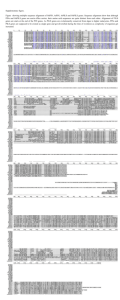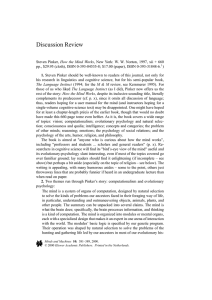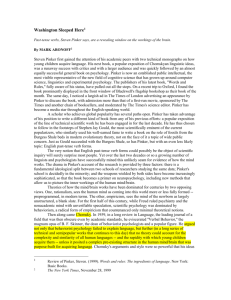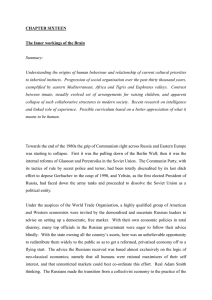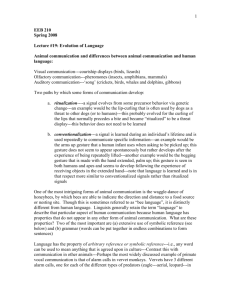EVOLUTION AND LANGUAGE
advertisement
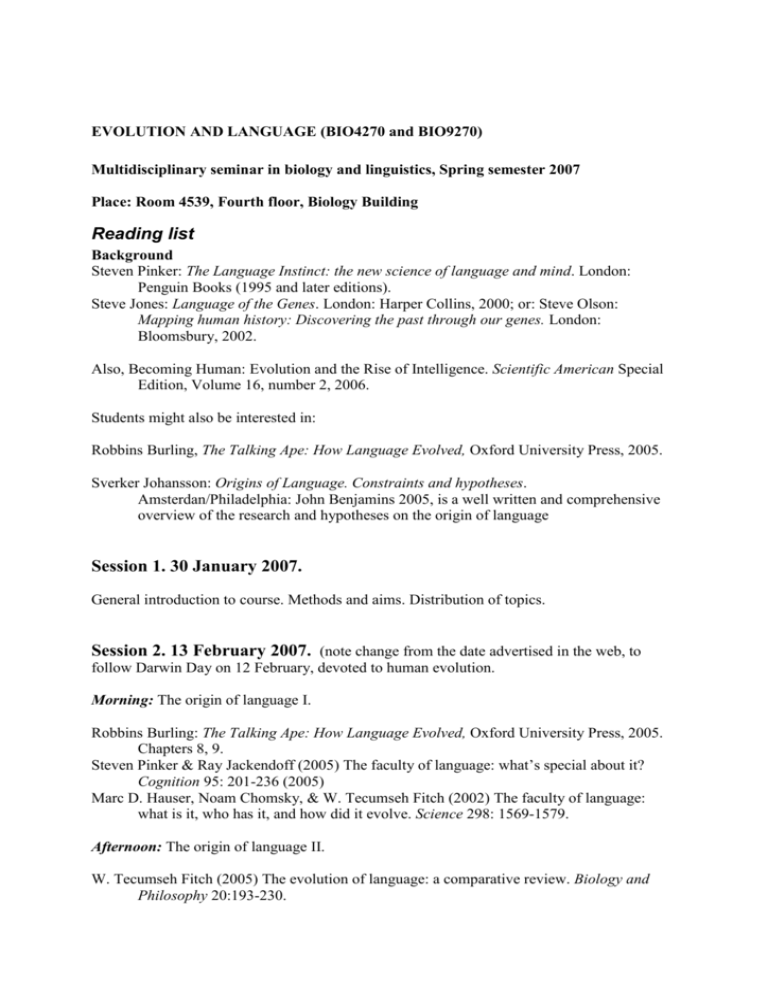
EVOLUTION AND LANGUAGE (BIO4270 and BIO9270) Multidisciplinary seminar in biology and linguistics, Spring semester 2007 Place: Room 4539, Fourth floor, Biology Building Reading list Background Steven Pinker: The Language Instinct: the new science of language and mind. London: Penguin Books (1995 and later editions). Steve Jones: Language of the Genes. London: Harper Collins, 2000; or: Steve Olson: Mapping human history: Discovering the past through our genes. London: Bloomsbury, 2002. Also, Becoming Human: Evolution and the Rise of Intelligence. Scientific American Special Edition, Volume 16, number 2, 2006. Students might also be interested in: Robbins Burling, The Talking Ape: How Language Evolved, Oxford University Press, 2005. Sverker Johansson: Origins of Language. Constraints and hypotheses. Amsterdan/Philadelphia: John Benjamins 2005, is a well written and comprehensive overview of the research and hypotheses on the origin of language Session 1. 30 January 2007. General introduction to course. Methods and aims. Distribution of topics. Session 2. 13 February 2007. (note change from the date advertised in the web, to follow Darwin Day on 12 February, devoted to human evolution. Morning: The origin of language I. Robbins Burling: The Talking Ape: How Language Evolved, Oxford University Press, 2005. Chapters 8, 9. Steven Pinker & Ray Jackendoff (2005) The faculty of language: what’s special about it? Cognition 95: 201-236 (2005) Marc D. Hauser, Noam Chomsky, & W. Tecumseh Fitch (2002) The faculty of language: what is it, who has it, and how did it evolve. Science 298: 1569-1579. Afternoon: The origin of language II. W. Tecumseh Fitch (2005) The evolution of language: a comparative review. Biology and Philosophy 20:193-230. Ray Jackendoff (1999) Possible stages in the evolution of the language capacity. Trends in Cognitive Sciences 3: 272-279. M. A. Novak & N. L. Komarova (2001) Towards and evolutionary theory of language. Trends in Cognitive Sciences 5: 288-295. Philip Lieberman (2002)On the nature and evolution of the neural bases of human language. Yearbook of Physical Anthropology 45: 36-62. Session 3. 20 February 2007. Morning: Did Neanderthals have the faculty of speech? R. I. M. Dunbar (2003) The social brain: mind, language and society in evolutionary perspective. Annual Review of Anthropology 32: 162-181. M. Balter (2002) What made humans modern? Science 295: 1219-1225. Ann MacLarnon & Gwen Hewitt (1999) The evolution of human speech: the role of enhanced breathing control. American Journal of Physical Anthropology 109: 341-363. James Noonan et al. (2006) Sequencing of Neanderthal genomic DNA. See also concurrent article in Nature (see below) and commentaries on both articles. Richard Green et al. (2006) Analysis of one million base pairs of Neanderthal DNA. Nature 444: 330-336. Afternoon: The search for language genes. Simon E. Fisher and Gary F. Marcus (2006) The eloquent ape: genes, brains and the evolution of language. Nature Reviews Genetics 7, 9-20 (January 2006). Wolfgang Enard et al. (2002) Molecular evolution of FOXP2, a gene involved in speech and language. Nature 418: 869-872. See also associated News and Views and commentary articles to this brief article. K. S. Pollard et al. (2006) An RNA gene expressed during cortical development evolved rapidly in humans. Nature 443: 167-172. See also associated commentary by C. P. Ponting and G. Lunter (2006) Human brain gene wins genome race Nature 443: 149150. D. V. M. Bishop (2002) Putting language genes in perspective. Trends in Genetics 18: 57-59. Jeffrey Wall (2000) Detecting ancient admixture in humans using sequence polymorphism data. Genetics 154: 1271-1279. Session 4. 6 March 2007. Morning: Language dispersal and recent human evolution. L.L. Cavalli-Sforza (1991) Genes, peoples and languages. Scientific American. p.72 Jared Diamond & Peter Bellwood (2003) Farmers and their languages: The first expansions. Science 300: 597-603. Jared Diamond (2000) Taiwan’s gift to the world. Nature 403: 709-710 (17 February 2000) R.R. Sokal , N.L. Oden & C. Wilson (1991) New genetic evidence supports the origin of agriculture by demic diffusion. Nature 351: 143-144; and short News & Views article by Steve Jones in the same issue of Nature. R. D. Gray & Q. D. Atkinson (2003) Language-tree divergence times support the Anatolian theory of Indo-European origin. Nature 426: 435-439 Russell Gray (2005) Pushing the time barrier in the quest for language roots. Science 309: 2007-2008. Michael Dunn et al. (2005)Structural phylogenetics and the reconstruction of ancient language history. Science 309: 2072-2075. Afternoon: The use of biological analogies to explain language evolution. Steven Pinker (2003) Language as an Adaptation to the Cognitive Niche. In Morten H. Christiansen and Simon Kirby: Language Evolution. Oxford: Oxford University Press. pp. 16-37. Salikoko Mufwene (2002) Competition and selection in language evolution. Selection 3.1: 4556. Derek Bickerton (2007) Language evolution: A brief guide for linguists. Lingua 117: 510526. Andrew Carstairs-McCarthy (2007) Language evolution: What linguists can contribute. Lingua 117: 503-509. Concluding discussion.





